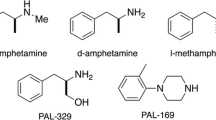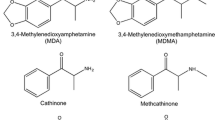Abstract
The effects of the monoamine uptake inhibitor Lu 19-005 ((±)-trans-3-(3,4-dichlorophenyl)-N-methyl-1-indanamine) and its (+) and (−) enantiomers, Lu 20-042 and Lu 20-043, were compared with those of cocaine and the selective dopamine uptake inhibitor GBR 12909 (1-{2-[bis-(4-fluorophenyl)methoxyl]ethyl}-4-(3-phenylpropyl)piperazin e) in behavioral and radioligand binding experiments. Behavioral experiments were conducted in groups of squirrel monkeys trained under fixed-interval schedules of reinforcement in which responding was maintained either by presentation of food or by termination of a visual stimulus associated with mild electric shock. Radioligand binding studies were conducted using [3H]CFT and [3H]GBR 12935 to label elements of the dopamine uptake system in caudate-putamen membranes of cynomolgus monkeys. All drugs produced dose-related increases in response rate under the fixed-interval schedules. Lu 19-005, Lu 20-042, and Lu 20-043 had relatively slow onsets (approximately 2 h) and relatively long durations of action, with effects persisting for two or more days following administration. Stereoselectivity was evident in the behavioral effects of the enantiomers of Lu 19-005, with Lu 20-042 being approximately 14 times more potent than Lu 20-043. In radioligand binding experiments, Lu 19-005 and its enantiomers were potent inhibitors of specifically bound [3H]CFT and [3H]GBR 12935. As in behavioral experiments, Lu 20-042 was more potent than Lu 20-043. The degree of stereoselectivity, however, varied with the temperature of the assay medium. At 37° C, Lu 20-043 was approximately 36 times more potent than Lu 20-043 in inhibiting the binding of [3H]CFT, whereas at 0–4° C, the difference in potency was only about 2-fold. The increased stereoselectivity at 37° C was due to a reduced potency for Lu 20-043. The results support the view that the behavioral effects of Lu 19-005 and its enantiomers are mediated at cocaine recognition sites associated with the dopamine uptake system. The results also show that incubation temperature can be a relevant factor in determining the relative potencies of drugs at [3H]CFT binding sites in vitro.
Similar content being viewed by others
References
Andersen PH (1989) The dopamine uptake inhibitor GBR 12909: selectivity and molecular mechanism of action. Eur J Pharmacol 166:493–504
Arnt J, Christensen AV, Hyttel J (1985) Pharmacology in vivo of the phenylindan derivative, Lu 19-005, a new potent inhibitor of dopamine, noradrenaline and 5-hydroxytryptamine uptake in rat brain. Naunyn-Schmiedeberg's Arch Pharmacol 329:101–107
Bergman J, Spealman RD (1988) Behavioral effects of histamine H1 antagonists: comparison with other drugs and modification by haloperidol. J Pharmacol Exp Ther 245:471–478
Bogeso KP, Christensen AV, Hyttel J, Liljefors T (1985) 3 phenyl-1-indanamines potential antidepressant activity and potent inhibition of dopamine norepinephrine and serotonin uptake. J Med Chem 28:1817–1828
Bogeso KP, Hyttel J, Christensen AV, Arnt J (1986) Chirality as determinant for neuroleptic or antidepressant action of drugs. In Naute WT, Rekker RF (eds) Innovative approaches in drug research. Pharmacochemistry library, vol 9. Elsevier, Amsterdam
Bonnet J-J, Costentin J (1986) GBR 12783. A potent and selective inhibitor of dopamine uptake: Biochemical studies in vivo and ex vivo. Eur J Pharmacol 121:199
Bonnet J-J, Benmansour S, Costentin J, Parker EM, Cubenddu LX (1990) Thermodynamic analyses of the binding of substrates and uptake inhibitors on the neuronal carrier of dopamine labeled with [3H]GBR 12783 or [3H]mazindol. J Pharmacol Exp Ther 253:1206–1214
Calligaro DO, Eldefrawi ME (1988) High affinity stereospecific binding of [3H]cocaine in striatum and its relationship to the dopamine transporter. Membr Biochem 7:87–106
De Oliveira A-M, Schoemaker H, Segonzac A, Langer SZ (1989) Differences in the temperature dependence of drug interaction with the noradrenaline and serotonin transporters. Neuropharmacology 28:823–828
Heikkila RE, Manzino L (1984) Behavioral properties of GBR 12909, GBR 13069 and GBR 13098: specific inhibitors of dopamine uptake. Eur J Pharmacol 103:241–248
Heikkila RE, Manzino L, Cabbat FS (1981) Stereospecific effects of cocaine derivatives on3H-dopamine uptake: correlations with behavioral effects. Subst Alcohol Actions Misuse 2:115–121
Hurd YL, Ungerstedt U (1989) In vivo neurochemical profile of dopamine uptake inhibitors and releasers in rat caudateputamen. Eur J Pharmacol 166:251–260
Janowsky A, Berger P, Vocci F, Labarca R, Skolnick P, Paul SM (1986) Characterization of sodium-dependent [3H]GBR-12935 binding in brain: a radioligand for selective labelling of the dopamine transport complex. J Neurochem 46:1272–1276
Kelleher RT (1977) Psychomotor stimulants. In: Pradhan SN, Dutta SN (eds) Drug abuse: the clinical and basic aspects. CV Mosby Co, St Louis, pp 116–147
Kelley AE, Lang CG (1989) Effects of GBR 12909, a selective dopamine uptake inhibitor, on motor activity and operant behavior in the rat. Eur J Pharmacol 167:385–395
Kennedy LT, Hanbauer I (1983) Sodium sensitive cocaine binding to rat striatal membrane possible relationship to dopamine uptake sites. J Neurochem 41:172–178
Kleven MS, Anthony EW, Woolverton WL (1990) Pharmacological characterization of the discriminative stimulus effects of cocaine in rhesus monkeys. J Pharmacol Exp Ther 254:312–317
Madras BK, Fahey MA, Canfield DR, Spealman RD (1988) D1 and D2 dopamine receptors in caudate-putamen of nonhuman primates (macaca fascicularis). J Neurochem 51:934–943
Madras BK, Fahey MA, Bergman J, Canfield DR, Spealman RD (1989a) Effects of cocaine and related drugs in nonhuman primates: I. [3H]cocaine binding sites in caudate-putamen. J Pharmacol Exp Ther 251:131–141
Madras BK, Spealman RD, Fahey MA, Neumeyer JL, Saha JK, Milius RA (1989b) Cocaine receptors labeled by [3H]2β-carbomethoxy-3β-(4-fluorophenyl)tropane. Mol Pharmacol 36:518–524
Madras BK, Fahey MA, Kaufman MJ (1990) [3H]CFT and [3H]LU 19-005: Markers for cocaine receptors/dopamine nerve terminals in Parkinson's disease. Soc Neurosci Abstr 16:14
Melia KF, Spealman RD (1991) Pharmacological characterization of the discriminative-stimulus effects of GBR 12909. J Pharmacol Exp Ther 258[2]:626–632
Morse WH, Kelleher RT (1966) Schedules using noxious stimuli. I. Multiple fixed-ratio and fixed-interval termination of schedule complexes. J Exp Anal Behav 9:267–290
Reith MEA, Sershen H, Lajtha A (1986) Binding sites for [3H]cocaine in mouse striatum and cerebral cortex have different dissociation kinetics. J Neurochem 46:309–312
Schoemaker H, Pimoule C, Arbilla S, Scatton B, Javoy-Agid F, Langer SZ (1985) Sodium dependent [3H]cocaine binding associated with dopamine uptake sites in the rat striatum and human putamen decrease after dopaminergic denervation and in Parkinsons disease. Naunyn-Schmiedeberg's Arch Pharmacol 329:227–235
Segonzac A, Schoemaker H, Langer SZ (1987) Temperature dependence of drug interaction with the platelet 5-hydroxytryptamine transporter: a clue to the imipramine selectivity paradox. J Neurochem 48:331–339
Spealman RD, Kelleher RT, Goldberg SR (1983) Stereoselective behavioral effects of cocaine and a phenyltropane analog. J Pharmacol Exp Ther 225[3]:509–514
Spealman RD, Madras BK, Bergman J (1989) Effects of cocaine and related drugs in nonhuman primates: II. Stimulant effects on schedule-controlled behavior. J Pharmacol Exp Ther 251:142–149
Author information
Authors and Affiliations
Additional information
Animals used in this study were maintained in accordance with the guidelines of the Committee on Animals of the Harvard Medical School and of the “Guide for Care and Use of Laboratory Animals” of the Institute of Laboratory Animal Resources, National Research Council, Department of Health, Education and Welfare, Publication No. (NIH)85-23, revised 1985. This research was supported by USPHS grants DA03774, DA06303, DA00499, and by Research Scientist Development Award DA00088 to RDS. Facilities and services were provided by the New England Regional Primate Research Center (USPHS Division of Research Resources Grant RR00168).
Rights and permissions
About this article
Cite this article
Rosenzweig-Lipson, S., Bergman, J., Spealman, R.D. et al. Stereoselective behavioral effects of Lu 19-005 in monkeys: relation to binding at cocaine recognition sites. Psychopharmacology 107, 186–194 (1992). https://doi.org/10.1007/BF02245136
Received:
Revised:
Issue Date:
DOI: https://doi.org/10.1007/BF02245136




